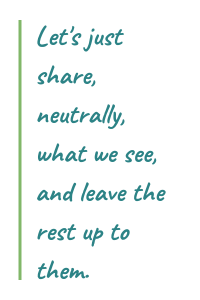Offer Your Two Cents with ‘COIN’
If you're going to offer your feedback to someone, prepare first so that your thoughts are clear and you've separated your emotional reaction to the situation from information that may be useful to the other person.
The COIN formula is one way to structure your feedback, starting with preparation.
C = Context
Frame the context so that your listener is brought to the right point in history to integrate the feedback. If there is any context that would help validate or normalize the current situation, that can help increase the receptivity of your feedback.
O = Observation
What was the behavior you observed? Here, it's important to describe it as a video camera would capture it, using words that are deliberately neutral and objective.
I = Impact
This is where you get to be subjective, stating the impact that the behavior had on you, and the concern you have about the behavior's impact on others. Giving feedback is vulnerable, too, and this is why. The impact on you might have to do with your own quirks, and you're sharing that.
N = New Behavior
What would work better from your perspective in terms of behaviors, habits, or interactions? This is the place for humble suggestions.
Here are some examples of feedback using the COIN framework:
“Your presentation last week had a few slides that felt a bit off topic. I found myself wondering how what you were saying on the budget slide fit into your main point, and then I had trouble following. I would absorb more if there was a clearly stated purpose and outline at the beginning that helped tie it together.”
"When you email me with a deliverable like last week, but it's missing a key part of what I requested. My conclusion is to assume you forgot. What would work better is to name it if you're only part way done with the request as you understood it.”
Feedback is vulnerable and subjective. We give it poorly at times and in ways that it won't make a difference, and we miss everyday opportunities to offer it humbly in ways that would add up to key differences. We get too wrapped up in other people's weaknesses; let's just share, neutrally, what we see, and leave the rest up to them.
You can see from these examples, there needs to be a place for feedback. I suggest building feedback into the structure of your weekly work rhythms.
And remember to use the COIN formula to offer your two cents for your message to have the greatest impact.


